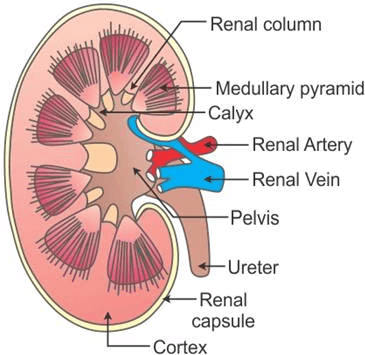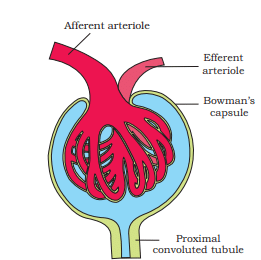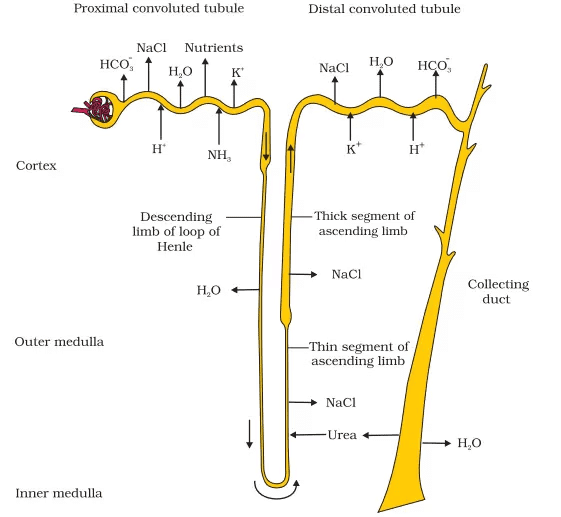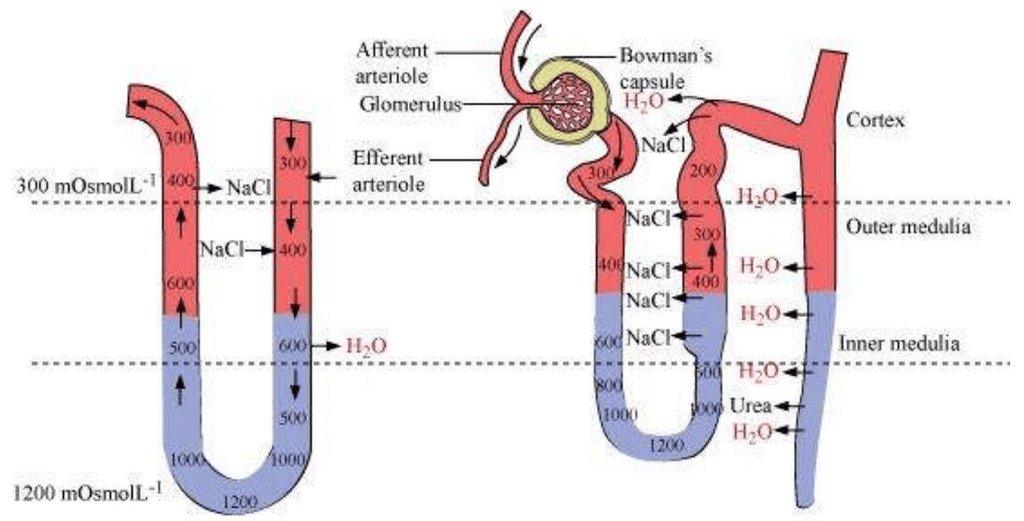Excretory Products and their Elimination Chapter Notes | Biology Class 11 - NEET PDF Download
Excretory Mechanisms in Animals
Animals accumulate various substances such as ammonia, urea, uric acid, carbon dioxide, water, and ions like Na + , K + , Cl – , phosphate, and sulfate, either through metabolic activities or excess ingestion. These substances need to be removed either totally or partially. This chapter focuses on the mechanisms of elimination, particularly common nitrogenous wastes.
Forms of Nitrogenous Wastes:
- Ammonia: Most toxic and requires a large amount of water for its elimination.
- Urea: Less toxic and conserves water.
- Uric Acid: Least toxic and can be removed with minimal water loss.
1. Ammonotelism:
- Refers to the excretion of ammonia.
- Common in bony fishes, aquatic amphibians, and aquatic insects.
- Ammonia is excreted by diffusion across body surfaces or through gill surfaces in fish as ammonium ions.
- Kidneys do not play a significant role in ammonia removal in these animals.
2. Ureotelic Animals:
- Definition: Animals that excrete urea.
- Examples: Mammals, many terrestrial amphibians, and marine fishes.
- Process: Ammonia produced by metabolism is converted into urea in the liver, released into the blood, and excreted by the kidneys.
- Osmolarity: Some animals retain urea in the kidney matrix to maintain desired osmolarity.
3. Uricotelic Animals:
- Definition: Animals that excrete uric acid.
- Examples: Reptiles, birds, land snails, and insects.
- Process: Uric acid is excreted in the form of pellets or paste with minimal water loss.
Excretory Structures in Animals
The animal kingdom exhibits a variety of excretory structures. Invertebrates typically have simple tubular excretory structures, while vertebrates possess complex tubular organs known as kidneys. Here are some examples of excretory structures in different animal groups:
- Protonephridia or Flame Cells: Found in Platyhelminthes (flatworms like Planaria), rotifers, some annelids, and the cephalochordate Amphioxus. Protonephridia are mainly involved in osmoregulation, regulating ionic and fluid volume.
- Nephridia: Tubular excretory structures in earthworms and other annelids. Nephridia help remove nitrogenous wastes and maintain fluid and ionic balance.
- Malpighian Tubules: Excretory structures in most insects, including cockroaches. Malpighian tubules aid in the removal of nitrogenous wastes and osmoregulation.
- Antennal Glands or Green Glands: Perform excretory functions in crustaceans like prawns.
Human Excretory System
The human excretory system is made up of a pair of kidneys, a pair of ureters, a urinary bladder, and a urethra.
 Human Excretory System
Human Excretory System
Kidneys
- The kidneys are reddish-brown, bean-shaped organs located between the last thoracic and third lumbar vertebrae, close to the dorsal inner wall of the abdominal cavity.
- Each kidney in an adult human measures about 10-12 cm in length, 5-7 cm in width, and 2-3 cm in thickness, with an average weight of 120-170 grams.
 Longitudinal section (Diagrammatic) of Kidney
Longitudinal section (Diagrammatic) of Kidney
- The outer layer of the kidney is a tough capsule, and inside, there are two zones: the outer cortex and the inner medulla.
- The medulla is divided into conical masses called medullary pyramids, which project into the calyces. The cortex extends between these pyramids, forming renal columns known as the Columns of Bertini.
- Each kidney contains nearly one million functional units called nephrons.
Nephrons
 A diagrammatic representation of a nephron showing blood vessels, duct and tubule
A diagrammatic representation of a nephron showing blood vessels, duct and tubule
- Each nephron has two main parts: the glomerulus and the renal tubule.
- The glomerulus is a tuft of capillaries formed by the afferent arteriole, a branch of the renal artery. Blood from the glomerulus is carried away by an efferent arteriole.
- The renal tubule begins with a cup-like structure called Bowman’s capsule, which encloses the glomerulus. Together, the glomerulus and Bowman’s capsule are known as the malpighian body or renal corpuscle.
 Malpighian body (renal corpuscle)
Malpighian body (renal corpuscle)
- The tubule continues to form a highly coiled network called the proximal convoluted tubule (PCT).
The Malpighian corpuscle, PCT, and distal convoluted tubule (DCT) are located in the cortical region of the kidney. The loop of Henle, which is part of the nephron, dips into the medulla.
There are two types of nephrons based on the length of the loop of Henle:
- Cortical nephrons have a short loop of Henle that extends only a little into the medulla.
- Juxtamedullary nephrons have a long loop of Henle that runs deep into the medulla.
Urine Formation
Urine formation involves three main processes: glomerular filtration, reabsorption, and secretion. The basic functional unit of kidneys is nephrons. Let us study these processes in detail.
1. Glomerular Filtration
- The process of filtering blood in the kidneys is known as glomerular filtration.
- The kidneys filter an average of 1100-1200 ml of blood per minute, which is about 1/5th of the blood pumped by each ventricle of the heart in a minute.
- Glomerular capillary blood pressure pushes blood through three layers:
(i) the endotheliumof glomerular blood vessels,
(ii) the epithelium of Bowman’s capsule, and
(iii) a basement membrane between these two layers. - The epithelial cells of Bowman’s capsule, called podocytes, are arranged to create small gaps known as filtration slits or slit pores.
- This filtration process is so fine that almost all plasma components, except proteins, pass into the lumen of Bowman’s capsule, making it a process of ultrafiltration.
Glomerular Filtration Rate (GFR)
- The amount of filtrate produced by the kidneys per minute is called the Glomerular Filtration Rate (GFR).
- In a healthy individual, GFR is approximately 125 ml/minute, which equals 180 litres per day.
- The kidneys have mechanisms to regulate GFR, one of which involves the juxtaglomerular apparatus (JGA).
- JGA is a sensitive area formed by cellular modifications in the distal convoluted tubule and the afferent arteriole where they meet.
- If GFR decreases, JG cells release renin, which helps restore glomerular blood flow and GFR to normal levels.
2. Reabsorption
- Despite the high volume of filtrate produced (180 litres per day), only about 1.5 litres is excreted as urine, indicating that nearly 99 per cent of the filtrate is reabsorbed by renal tubules.
- This process, known as reabsorption, is carried out by tubular epithelial cells in different segments of the nephron using either active or passive mechanisms.
- For instance, substances like glucose, amino acids, and sodium ions (Na+) are reabsorbed actively, while nitrogenous wastes are absorbed passively.
- Water reabsorption also occurs passively in the initial segments of the nephron.
 Reabsorption and secretion of major substances at different parts of the nephron (Arrows indicate direction of movement of materials.)
Reabsorption and secretion of major substances at different parts of the nephron (Arrows indicate direction of movement of materials.)
3. Secretion
- During urine formation, tubular cells secrete substances such as hydrogen ions (H+), potassium ions (K+), and ammonia into the filtrate.
- Tubular secretion is crucial for maintaining the ionic and acid-base balance of body fluids.
Functions of the Renal Tubules
(i) Proximal Convoluted Tubule (PCT). The PCT is lined with simple cuboidal brush border epithelium, which increases the surface area for reabsorption. This segment reabsorbs nearly all essential nutrients, along with 70-80% of electrolytes and water. Additionally, the PCT helps maintain the pH and ionic balance of body fluids by selectively secreting hydrogen ions and ammonia into the filtrate and absorbing bicarbonate ions (HCO₃⁻) from it.
(ii) Henle’s Loop. Ascending Limb. Reabsorption is minimal, but this region is crucial for maintaining the high osmolarity of the medullary interstitial fluid. Descending Limb. This limb is permeable to water but nearly impermeable to electrolytes, which concentrates the filtrate as it descends. Ascending Limb. Impermeable to water but allows the active or passive transport of electrolytes, diluting the filtrate as it ascends.
(iii) Distal Convoluted Tubule (DCT). In this segment, there is conditional reabsorption of sodium ions (Na⁺) and water. The DCT can also reabsorb bicarbonate ions (HCO₃⁻) and selectively secrete hydrogen ions (H⁺), potassium ions (K⁺), and ammonia (NH₃) to maintain pH and sodium-potassium balance in the blood.
(iv) Collecting Duct. This duct extends from the cortex of the kidney into the inner medulla. It reabsorbs large amounts of water, producing concentrated urine. The collecting duct also allows small amounts of urea to pass into the medullary interstitium to maintain osmolarity. Additionally, it helps regulate pH and ionic balance in the blood by selectively secreting hydrogen ions (H⁺) and potassium ions (K⁺).
Mechanism of Concentration of the Filtrate
- Mammals possess the remarkable ability to generate concentrated urine, a process significantly influenced by Henle's loop and the vasa recta. The flow of filtrate in the two limbs of Henle's loop occurs in opposite directions, creating a countercurrent effect. Similarly, the blood flow through the two limbs of the vasa recta also follows a countercurrent pattern.
- The close proximity of Henle's loop and the vasa recta, combined with their countercurrent flow, is crucial for maintaining an increasing osmolarity towards the inner medullary interstitium. This osmolarity gradient ranges from approximately 300 mOsmolL–1 in the cortex to around 1200 mOsmolL–1 in the inner medulla. The gradient is primarily established by NaCl and urea.
 Counter Current Mechanism
Counter Current Mechanism
Mechanism of Concentration
- NaCl Transport: The ascending limb of Henle's loop transports NaCl, which is exchanged with the descending limb of the vasa recta. NaCl is then returned to the interstitium by the ascending portion of the vasa recta.
- Urea Transport: Small amounts of urea enter the thin segment of the ascending limb of Henle's loop and are transported back to the interstitium by the collecting tubule.
This intricate transport process, facilitated by the special arrangement of Henle's loop and the vasa recta, is known as the countercurrent mechanism.
The countercurrent mechanism is vital for maintaining a concentration gradient in the medullary interstitium. This gradient allows for the efficient passage of water from the collecting tubule, leading to the concentration of the filtrate (urine). Remarkably, human kidneys can produce urine that is nearly four times more concentrated than the initial filtrate.
Regulation of Kidney Function
The regulation of kidney function is primarily governed by hormonal feedback mechanisms involving the hypothalamus, the juxtaglomerular apparatus (JGA), and, to some extent, the heart. These mechanisms are triggered by changes in blood volume, body fluid volume, and ionic concentration, which are detected by osmoreceptors in the body. Role of Osmoreceptors and Antidiuretic Hormone (ADH)
- Osmoreceptors are activated when there is excessive fluid loss from the body, leading to changes in blood volume and ionic concentration.
- In response, the hypothalamus signals the release of antidiuretic hormone (ADH), also known as vasopressin, from the neurohypophysis.
- ADH plays a crucial role in facilitating water reabsorption from the latter parts of the renal tubule, thereby preventing diuresis (excessive urination).
- When body fluid volume increases, the osmoreceptors are switched off, leading to the suppression of ADH release, completing the feedback loop.
- ADH also affects kidney function by constricting blood vessels, which increases blood pressure. This rise in blood pressure can enhance glomerular blood flow and, consequently, the glomerular filtration rate (GFR).
(I) Role of the Juxtaglomerular Apparatus (JGA)
- The JGA plays a complex regulatory role in kidney function.
- When there is a decrease in glomerular blood flow, glomerular blood pressure, or GFR, the juxtaglomerular (JG) cells in the JGA are activated to release renin.
- Renin converts angiotensinogen in the blood to angiotensin I, which is further converted to angiotensin II.
- Angiotensin II is a powerful vasoconstrictor that increases glomerular blood pressure and GFR.
- Additionally, angiotensin II stimulates the adrenal cortex to release aldosterone.
(II) Role of Aldosterone
- Aldosterone promotes the reabsorption of sodium (Na+) and water from the distal parts of the renal tubule.
- This reabsorption leads to an increase in blood pressure and GFR.
- This intricate process is known as the Renin-Angiotensin mechanism.
(III) Role of Atrial Natriuretic Factor (ANF)
- An increase in blood flow to the atria of the heart can trigger the release of Atrial Natriuretic Factor (ANF).
- ANF promotes vasodilation (the widening of blood vessels), which decreases blood pressure.
- The ANF mechanism acts as a counterbalance to the renin-angiotensin mechanism, helping to regulate blood pressure and kidney function.
Micturition
The urine produced by the nephrons is eventually transported to the urinary bladder, where it is stored until a voluntary signal is received from the central nervous system (CNS). This signaling process is triggered by the stretching of the urinary bladder as it fills with urine. In response to this stretching, the stretch receptors located in the bladder walls send signals to the CNS.
- The CNS then relays motor messages to initiate the contraction of the smooth muscles in the bladder while simultaneously relaxing the urethral sphincter, leading to the release of urine.
- This process of urine release is known as micturition, and the neural mechanisms that govern it are referred to as the micturition reflex.
- On average, an adult human excretes about 1 to 1.5 liters of urine per day.
- The urine produced is typically a light yellow, watery fluid with a slightly acidic pH of around 6.0 and a characteristic odor.
- Each day, approximately 25 to 30 grams of urea are excreted in the urine.
- Various conditions can impact the properties of urine, and urine analysis is a valuable tool in the clinical diagnosis of various metabolic disorders and kidney malfunctions.
- For instance, the presence of glucose (a condition known as glycosuria) and ketone bodies (known as ketonuria) in urine can indicate diabetes mellitus.
Role of Other Organs in Excretion
Apart from the kidneys, other organs like the lungs, liver, and skin also contribute to the elimination of excretory wastes.
(i) Lungs. The lungs play a significant role in removing large amounts of carbon dioxide (CO 2 ) and water from the body. They eliminate approximately 200 mL of CO 2 per minute, along with significant quantities of water daily.
(ii) Liver. The liver, being the largest gland in the body, secretes bile that contains substances such as bilirubin, biliverdin, cholesterol, degraded steroid hormones, vitamins, and drugs. Most of these substances eventually pass out of the body along with digestive wastes.
(iii) Skin. The skin, through its sweat and sebaceous glands, can eliminate certain substances.
- Sweat Glands. Sweat is a watery fluid produced by sweat glands that contains sodium chloride (NaCl), small amounts of urea, lactic acid, and other substances. While the primary function of sweat is to cool the body, it also aids in the removal of some wastes.
- Sebaceous Glands. Sebaceous glands secrete sebum, which contains sterols, hydrocarbons, and waxes. This secretion provides a protective oily covering for the skin.
Saliva. Interestingly, small amounts of nitrogenous wastes can also be eliminated through saliva.
Disorders of the Excretory System
1. Uremia is a condition that occurs when the kidneys are not functioning properly, leading to the buildup of urea in the blood. This can be harmful and may result in kidney failure.
2. Renal calculi: Stone or insoluble mass of crystallised salts (oxalates, etc.) formed within the kidney.
3. Glomerulonephritis: Inflammation of glomeruli of kidney.
Process of Hemodialysis
During hemodialysis, blood is taken from a suitable artery and sent to a machine called an artificial kidney. To prevent blood from clotting, an anticoagulant like heparin is added. Inside the machine, there is a coiled cellophane tube filled with a fluid that resembles plasma, but without nitrogenous wastes.
Function of the Cellophane Membrane
The cellophane membrane is porous and allows molecules to pass through it based on their concentration gradient. Since the dialyzing fluid does not contain nitrogenous wastes, these harmful substances move out of the blood, effectively cleaning it of toxins.
Return of Cleared Blood
After the blood is cleared of toxins, it is pumped back into the body through a vein, with anti-heparin added to prevent clotting. Hemodialysis is a vital and life-saving treatment for many patients suffering from uremia worldwide.
Kidney Transplantation
Kidney transplantation is regarded as the most effective treatment for acute renal failure, a condition in which the kidneys are unable to carry out their necessary functions. In this procedure, a healthy kidney from a donor, preferably a close relative, is transplanted into the patient. Choosing a genetically related donor helps minimize the risk of the immune system rejecting the transplanted kidney.
Advances in modern clinical techniques have greatly enhanced the success rates of kidney transplantation, making it a feasible option for individuals with severe kidney failure.
|
183 videos|524 docs|136 tests
|
FAQs on Excretory Products and their Elimination Chapter Notes - Biology Class 11 - NEET
| 1. What are the main excretory products in humans and how are they eliminated? |  |
| 2. How does urine formation occur in the human excretory system? |  |
| 3. What is the role of renal tubules in kidney function? |  |
| 4. How is the concentration of filtrate regulated in the kidneys? |  |
| 5. What are some common disorders of the excretory system? |  |
















